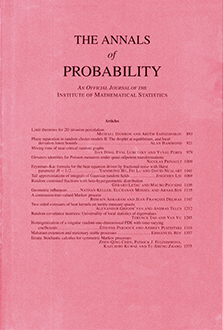Abstract
We consider an elementary model of random size varying population governed by a stationary continuous-state branching process. We compute the distributions of various variables related to the most recent common ancestor (MRCA): the time to the MRCA, the size of the current population and the size of the population just before the MRCA. In particular we observe a natural mild bottleneck effect as the size of the population just before the MRCA is stochastically smaller than the size of the current population. We also compute the number of individuals involved in the last coalescent event of the genealogical tree, that is, the number of individuals at the time of the MRCA who have descendants in the current population. By studying more precisely the genealogical structure of the population, we get asymptotics for the number of ancestors just before the current time. We give explicit computations in the case of the quadratic branching mechanism. In this case, the size of the population at the MRCA is, in mean, $2/3$ of the size of the current population. We also provide in this case the fluctuations for the renormalized number of ancestors.
Citation
Yu-Ting Chen. Jean-François Delmas. "Smaller population size at the MRCA time for stationary branching processes." Ann. Probab. 40 (5) 2034 - 2068, September 2012. https://doi.org/10.1214/11-AOP668
Information





